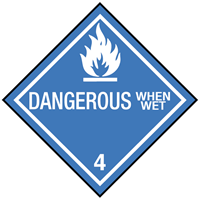
 Print
Print
Chemical Datasheet
SODIUM AMIDE |

|
Chemical Identifiers
| CAS Number |
UN/NA Number |
DOT Hazard Label |
USCG CHRIS Code |
|
|
|
|
|
| NIOSH Pocket Guide |
International Chem Safety Card |
|
none
|
none
|
NFPA 704
data unavailable
General Description
Odorless colorless solid. Denser than water.
Hazards
Reactivity Alerts
- Highly Flammable
- Strong Reducing Agent
- Water-Reactive
- Peroxidizable Compound
Air & Water Reactions
Highly flammable. Reacts violently with water and bursts into flame.
Fire Hazard
Special Hazards of Combustion Products: Toxic and irritating ammonia gas may be formed. (USCG, 1999)
Health Hazard
Ammonia gas formed by reaction of solid with moisture irritates eyes and skin. Solid causes caustic burns of eyes and skin. Ingestion burns mouth and stomach in same way as caustic soda and may cause perforation of tissue. (USCG, 1999)
Reactivity Profile
SODIUM AMIDE is a powerful reducing agent. Reacts violently with oxidizing agents. Reacts violently with steam and water to form caustic NaOH and NH3 vapors [Bergstrom et al., Chem. Reviews, 12:6 1932]. May form explosive compounds in the presence of water and carbon dioxide [Handling Chemicals Safely 1980 p 826]. Liable to deflagration upon heating and friction. Forms an explosive peroxide on storage. When sodium amide and chromic anhydride are mixed together a vigorous reaction results; the same occurs with other oxidizing agents including dinitrogen tetraoxide, potassium chlorate, sodium nitrite. [Mellor 11:234 1946-47]. Reaction with 1,1-diethoxy-2- chloroethane produces sodium ethoxyacetylide, which is extremely pyrophoric [Rutledge 1968 p. 35]. Reactions with halogenated hydrocarbons may be violently explosive. Sodium amide forms toxic and flammable H2S gas with CS2. (714).
Belongs to the Following Reactive Group(s)
- Bases, Strong
- Nitrides, Phosphides, Carbides, and Silicides
Potentially Incompatible Absorbents
Use caution: Liquids with this reactive group classification have been
known to react with the
absorbents
listed below.
- Cellulose-Based Absorbents
- Mineral-Based & Clay-Based Absorbents
Response Recommendations
Isolation and Evacuation
Excerpt from ERG Guide 139 [Substances - Water-Reactive (Emitting Flammable and Toxic Gases)]:
IMMEDIATE PRECAUTIONARY MEASURE: Isolate spill or leak area in all directions for at least 50 meters (150 feet) for liquids and at least 25 meters (75 feet) for solids.
SPILL: See ERG Table 1 - Initial Isolation and Protective Action Distances on the UN/NA 1390 datasheet.
FIRE: If tank, rail tank car or highway tank is involved in a fire, ISOLATE for 800 meters (1/2 mile) in all directions; also, consider initial evacuation for 800 meters (1/2 mile) in all directions. (ERG, 2024)
Firefighting
Fire Extinguishing Agents Not to Be Used: Water
Fire Extinguishing Agents: Dry soda ash, graphite, salt, or other recommended dry powder, such as dry limestone. (USCG, 1999)
Non-Fire Response
Neutralizing Agents for Acids and Caustics: Caustic solution formed by reaction with water can be diluted with water and/or neutralized by acetic acid. (USCG, 1999)
Protective Clothing
Goggles or face shield; dust respirator; rubber gloves and shoes. (USCG, 1999)
DuPont Tychem® Suit Fabrics
No information available.
First Aid
INGESTION: give water or milk followed by dilute vinegar or fruit juice; do NOT induce vomiting; call a doctor.
SKIN OR EYES: flood all affected areas with copious amounts of water. (USCG, 1999)
Physical Properties
Flash Point: data unavailable
Lower Explosive Limit (LEL): data unavailable
Upper Explosive Limit (UEL): data unavailable
Autoignition Temperature: data unavailable
Melting Point:
410°F
(USCG, 1999)
Vapor Pressure: data unavailable
Vapor Density (Relative to Air): data unavailable
Specific Gravity:
1.39
at 68°F
(USCG, 1999)
- Denser than water; will sink
Boiling Point:
752°F
at 760 mmHg
(USCG, 1999)
Molecular Weight:
39.01
(USCG, 1999)
Water Solubility: data unavailable
Ionization Energy/Potential: data unavailable
IDLH: data unavailable
AEGLs (Acute Exposure Guideline Levels)
No AEGL information available.
ERPGs (Emergency Response Planning Guidelines)
No ERPG information available.
PACs (Protective Action Criteria)
No PAC information available.
Regulatory Information
EPA Consolidated List of Lists
No regulatory information available.
CISA Chemical Facility Anti-Terrorism Standards (CFATS)
No regulatory information available.
OSHA Process Safety Management (PSM) Standard List
No regulatory information available.
Alternate Chemical Names


 Print
Print
